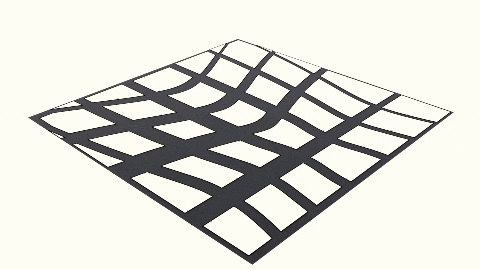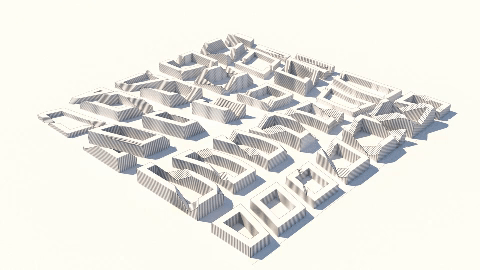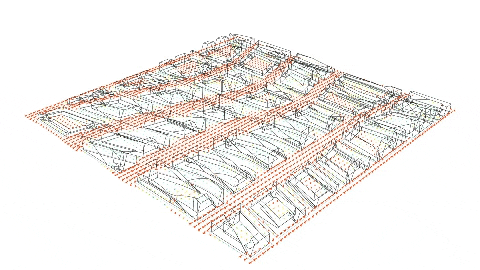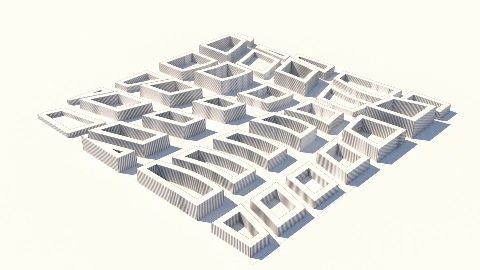algorithmic modeling for Rhino
This list is not comprehensive but a starting point for any planning project.
In a successfully designed urban plan the designer needs to manage and manipulate multiple interconnected parameters. Each parameter can be investigated and developed independently, but will also have to be tested in relation to other related parameters. This can be done using analogue or digital methods or both.
The complexity of these relations does make digital methods preferable as designers can then introduce optimization through the use of algorithms. However, there is also a need to introduce some chaos/unexpected elements into the system, which does not lend itself easily to simple digital coding.
Cities are complex systems and this list or urban parameters is not comprehensive but will give an idea of the basic variables for a systemic approach to urban design.
1. FACILITATE SPACES FOR LIVING, WORKING, SHOPPING AND RECREATION
In urban theory spaces are categorized according to the three basic functions or urban life: Home = 1st space, Work = 2nd Space, and recreation/spaces not work or home = 3rd space. The fundamental purpose of urban design is to provide these for the urban population. If design methods or policies ignore this primary directive, they fail fundamentally.
The current housing crisis in many major western cities demonstrate the failure of their planning policies and urban designers. While development of slums in developing countries is another example of this failure, for different reasons, but both are due to broken systems.
Emergence of favelas is a successful development where local population steps in to manage the failure of urban planning. Favelas are an example of how urban environment is capable of self-organizing large and complex urban plans.
To the other extreme, facilitating user spaces also means not to construct, or reduce urban development when needed. As an example, the construction of “ghost cities” in places like China and Turkey is a failure to manage this basic parameter, while the de-industrialization of Detroit is a challenge of urban reduction which seems to be working.
On the micro level, working at home will become an increasing demand in the future, with not just pressure on internal space allocation and planning, but also the 24 hour functionality of neighbourhoods. All affecting the macro level directly.
2. TRAVEL TIMES
 Transport is not about speed, it’s about time, mass and cost. How to move the greatest number of people in the least amount of time with the least effort. This is one of the easiest parameters to lose sight of in the bigger picture: “It takes me too long to drive to work due to traffic, so we need more roads and overpasses”.
Transport is not about speed, it’s about time, mass and cost. How to move the greatest number of people in the least amount of time with the least effort. This is one of the easiest parameters to lose sight of in the bigger picture: “It takes me too long to drive to work due to traffic, so we need more roads and overpasses”.
An example of not seeing the trees for the forest, this was the go-to urban problem solving up to the start of the century. In reality more roads cause more traffic jams through something called ‘Induced Demand”.
The simplest solution is to reduce distances and, in that way, reduce travel time. Increasing the density of the built environment shortens the average distances. This however will bounce up against the quality of the urban environment; external spaces, daylight and so on (see 3 below).
Any quality of life measurement will look at the type of transportation system and how people use it. The use of the system is a great indicator of the ease of use and health of the urban environment. This is measured through the transport type, from the best to the worst transport types:
- Walk
- Bicycle
- Mass transit
- Semi-mass transit
- Private automobile
Dense, functional and people friendly cities are cheaper per resident, more resilient and flexible than sprawling suburban cities.
3. DENSITY
An important variable in many of the other parameters, density breaks down into the areas/volume of space each resident is allocated for living, working and 3rd space. Density needs to be measured against other parameters to introduce quality into the proposal. When this is not done, the result can start resembling the form of Kowloon Walled City. If you are going for a Blade Runner-esque urban environment this might be an option.
4. DAYLIGHT & SUNLIGHT
Daylight is necessary for everyday activities internally and externally. It affects people’s psychology and is a major factor in determining the quality of a space. This is a very contextual parameter with locations closer to the poles having different needs than locations closer to the equator.
Natural light is different from direct sunlight, which is even more of a contextual factor  than daylight. Warm places closer to the equator need shade from the sun, especially in the summer. Cold places closer to the poles need the direct sun to make external and internal spaces more pleasant.
than daylight. Warm places closer to the equator need shade from the sun, especially in the summer. Cold places closer to the poles need the direct sun to make external and internal spaces more pleasant.
The Sun is a great tool to passively reduce energy consumption. Passive solar gain during cold months and the ability to place solar panels are all positive solutions. In the warmer months, solar gain needs to be reduced through passive design. The ability for architects to design with daylight and sunlight starts with the design of the urban environment.
5. WIND
The wind is one of the most complex parameters to model in the digital environment. Much like the
 sun, wind parameter depends on the location of the site. Cold locations need shelter from the wind, while prominent local winds can passively cool down hot urban environments. The original western grid design by Hippodamus of Miletus was used to bring the morning and evening sea-breeze into the Greek coastal cities to cool them down.
sun, wind parameter depends on the location of the site. Cold locations need shelter from the wind, while prominent local winds can passively cool down hot urban environments. The original western grid design by Hippodamus of Miletus was used to bring the morning and evening sea-breeze into the Greek coastal cities to cool them down.
Wind is 3 dimensional and has a complex relationship with high-rise development. Massing forms will affect structural wind-loads, localized ground wind nuisance, and the ability to use balconies amongst many other factors.
This does offer the opportunity for wind power generation. However, there are very few successful architectural examples of this in an urban environment.
6. VIEW
Views are not just long views over open landscape and public spaces. These also include the visual engagement with the street and local neighbors. They can also be either towards an important focal point or a wide aspect. Here it is important to keep in mind that if the various scales are not considered, the designer might create an economical hierarchy based on better views.
Outlook is a counter parameter to density, but this can be alleviated by clever massing and formal approaches to the urban fabric. It can also be countered with good architectural design. People mind less about short views if they are presented with something pleasant to look at. Both Barcelona and Paris are dense urban grids, but complain less about the lack of view than the Brits. View-lines and visual aspects can operate as parameters.
You can find more in my blog at: https://www.thorarchitects.com/15-parameters-urban-design/
#architecture #urbandesign #parametric #architecturelovers #modernarchitecture #landscapearchitecture #urbanism #greenarchitecture #thorarchitects #computationaldesign #masterplanning #designoptimization #avantgarde #sustainablearchitecture #parametricdesign #grasshopper3d #contemporaryarchitecture #architecturelover #architects
Views: 4344
Comment
-
Comment by MillieJordon on December 26, 2022 at 10:48pm
-
As we continue to evolve as a society, it is important that we develop new ways to design our cities. This can be done by applying parametric urbanism, which is a method of designing cities based on data and information.The goal of parametric urbanism is to create designs that are flexible, adaptable and customizable. The process involves creating models and then making changes to those models over time. For online slots I always prefer visiting https://chilecasinoonline.com/juegos/tragamonedas/ website because it helps you to locate the best platform where you can enjoy wonderful casino games.
© 2026 Created by Scott Davidson.
Powered by
![]()


You need to be a member of Grasshopper to add comments!